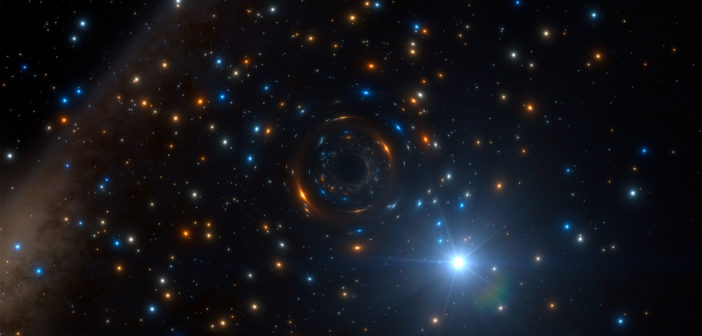How many black holes lurk within the dense environments of globular clusters, and how do these powerful objects shape the properties of the cluster around them? One such cluster, NGC 3201, is now helping us to answer these questions.
Hunting Stellar-Mass Black Holes
Since the detection of merging black-hole binaries by the Laser Interferometer Gravitational-Wave Observatory (LIGO), the dense environments of globular clusters have received increasing attention as potential birthplaces of these compact binary systems.

The central region of the globular star cluster NGC 3201, as viewed by Hubble. The black hole is in orbit with the star marked by the blue circle. [NASA/ESA]
Now a team of scientists led by Kyle Kremer (CIERA and Northwestern University) is using models of this system to better understand the impact that black holes might have on their host clusters.
A Model Cluster
The relationship between black holes and their host clusters is complicated. Though the cluster environment can determine the dynamical evolution of the black holes, the retention rate of black holes in a globular cluster (i.e., how many remain in the cluster when they are born as supernovae, rather than being kicked out during the explosion) influences how the host cluster evolves.
Kremer and collaborators track this complex relationship by modeling the evolution of a cluster similar to NGC 3201 with a Monte Carlo code. The code incorporates physics relevant to the evolution of black holes and black-hole binaries in globular clusters, such as two-body relaxation, single and binary star evolution, galactic tides, and multi-body encounters. From their grid of models with varying input parameters, the authors then determine which fit best to NGC 3201’s final observational properties.

Surface brightness profiles for all globular-cluster models at late times compared to observations of NGC 3201 (yellow circles). Blue lines represent models with few retained black holes; black lines represent models with many retained black holes. [Kremer et al. 2018]
Retention Matters
Kremer and collaborators find that the models that best represent NGC 3201 all retain more than 200 black holes at the end of the simulation; models that lost too many black holes due to natal kicks did not match observations of NGC 3201 as well. The models with large numbers of retained black holes also harbored binaries just like the one recently detected in NGC 3201.
Models that retain few black holes, on the other hand, may instead be good descriptions of so-called “core-collapsed” globular clusters observed in the Milky Way. The authors demonstrate that these clusters could contain black holes in binaries with stars known as blue stragglers, which may also be detectable with radial velocity techniques.
Kremer and collaborators’ results suggest that globular clusters similar to NGC 3201 contain hundreds of invisible black holes waiting to be discovered, and they indicate some of the differences in cluster properties caused by hosting such a large population of black holes. We can hope that future observations and modeling will continue to illuminate the complicated relationship between globular clusters and the black holes that live in them.
Citation
Kyle Kremer et al 2018 ApJL 855 L15. doi:10.3847/2041-8213/aab26c

2 Comments
Pingback: BHs shaping globular clusters
Pingback: Shaping Globular Clusters with Black Holes – CIERA